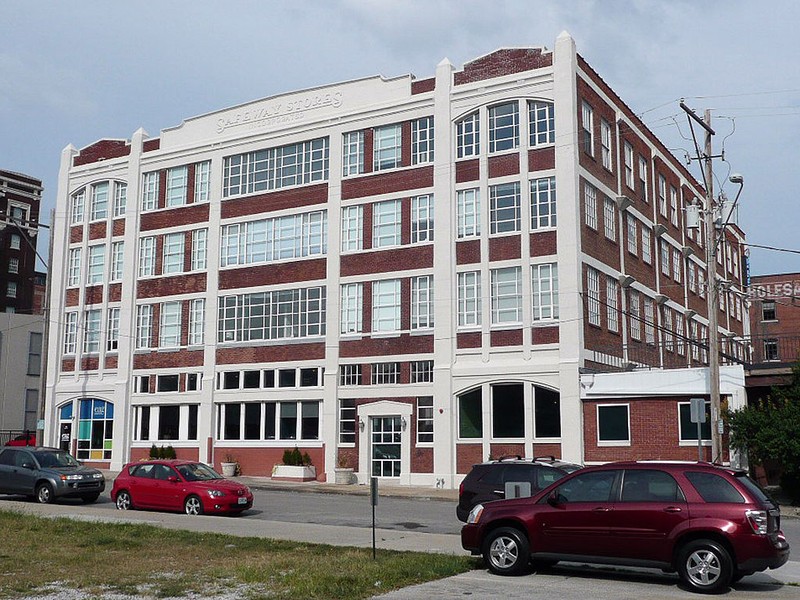Safeway Stores Office and Warehouse Building
Introduction
Text-to-speech Audio
This historic building in the Kansas City Crossroads District was completed in 1929 for use as a warehouse and headquarters for the supermarket chain Safeway, once a major national chain that was founded in 1915. Designed by Kansas City architects Archer and Gloyd, the warehouse and company office space was built by J.H. Construction Company in 1929 in the commercial style that was popular in the United States in the 19th and 20th centuries. The building was acquired by the Kansas City department store Halls in 1953 and later developed into loft-style apartments, a change that reflects the building's proximity to downtown and the development of the Crossroads District into a popular destination for arts and entertainment.
Images
Built for the Safeway grocery chain, this historic warehouse and office building was purchased by Halls in 1953

Backstory and Context
Text-to-speech Audio
Safeway was founded in American Falls, Idaho by Missouri-born Martin B. Skaggs in 1915. Skaggs developed retail strategies that involved bulk-selling and used a method of expanding and merging stores and corporations. Together, these strategies allowed Skaggs to expand throughout the Western United States, and by 1929, there were 2,000 Safeway locations throughout the West.
Safeway's rapid growth created a need for a distribution center located at the center of the nation. Safeway selected Kansas City, Missouri, and hired the J.H. Thompson Construction Company who completed this building in 1929. Since that time, the structure has seen a few alterations, such as the 1939 redesign of the interior by Kansas City architect Charles E. Keyser. In 1949, a loading dock was added to the south side of the building and in 1979, a one-story addition was added to the north side. Otherwise, its integrity has been maintained throughout the years and still largely reflects what the building would have looked like while it was still operating.
Safeway came to Kansas City at an interesting moment in history. The anti-chain store movement gained some followers in the area after Kansas City businessman Charles H. Lyon took a tour by car through the Great Plains. Lyon noticed all the towns had the same exact stores and sent a letter to then-President Franklin D. Roosevelt that claimed that for every one chain store in a town, three individually owned stores died. The letter also claimed that chain stores made mainstreets aesthetically unappealing and damaged the nation’s character because “individual stores [were] the backbone of a nation.” He proposed to Roosevelt that chain stores should be taxed high enough that individual stores could compete with chains, which wasn’t a new idea at the time but had more of an impact as the nation was in the throes of the Great Depression. Ultimately, the anti-chain movement lost momentum by the mid-1930s, and Safeway found success in Kansas City.
Kansas City was chosen not only for its centralized location, but also because of its access to the railroads and because of the development of trucking. A method of docking called “cross-docking” was utilized, meaning “goods were off-loaded by vendors and then transferred to the surrounding retail stores.” These surrounding stores were in places such as St. Joseph, Joplin, and the area spanning out to Topeka, Kansas, and Columbia.
Aside from distribution, the building was also used as a coffee plant, and a bakery. The structure eventually became home to the district offices for Safeway. The building was purchased by the Halls Company (now known as Hallmark) in 1953 and no longer operates as a distribution center.
Sources
Missouri SP Safeway Stores and Office and Warehouse Building, National Archives Catalog. Accessed August 30th, 2022. https://catalog.archives.gov/id/63819339.
National Register of Historic Places Registration Form, MO State Parks. Accessed August 31st, 2022. https://mostateparks.com/sites/mostateparks/files/Safeway%20Stores%20and%20Office%20and%20WH%20Bldg.pdf.
Scroop, Daniel. The Anti-Chain Store Movement and the Politics of Consumption. American Quarterly, vol. Vol. 60, no. No. 4pp. 925 - pp. 949. Published December 1st, 2008. jstor.org.
https://commons.wikimedia.org/wiki/File:Safeway_Stores_and_Office_and_Warehouse_Building.jpg
